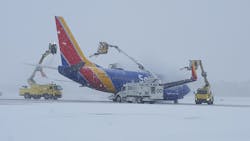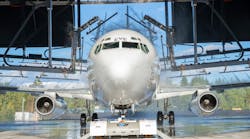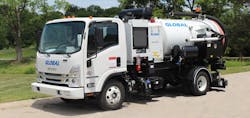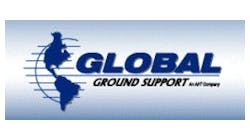The Dos and Don'ts of Deicing
It’s snowing, blowing and the deicing trucks are hard at work spraying planes to get them out on time. But as the aircraft deicing fluid (ADF) slides off the aircraft’s wings and down into the storm drain, where does it go and what happens to it?
“This is my 20th year in the industry and for the first half of my career I sprayed hundreds of gallons of ADF onto aircraft and I watched it go into the storm drain, and for an applier, it’s always in the back of your mind: where’s all that fluid going to?” Adam Thurlow, Site Operations Manager for Inland Technologies at Portland International Jetport (PWM).
While non-toxic, propylene glycol – the main ingredient in ADF – does pose an environmental threat.
“By design, glycol absorbs moisture which is the same as absorbing oxygen. It has a very high biological oxygen demand. When propylene glycol enters an aquatic environment, it acts as a food source for some microbes so it eventually will break down into harmless molecules. This is tolerable in small quantities. A problem arises with higher concentrations of propylene glycol because the microbes also use oxygen from the water to digest the food source. This increase in Biological Oxygen Demand can starve other aquatic life of oxygen, thus affecting the environment,” Thurlow explained.
For years, spent ADF had been discharged into the Fore River, Paul Bradbury, Airport Director of the Portland International Jetport, said.
“Historically, ADF at airports has been directly discharged into local tributaries or estuaries, which are tidal areas if you’re right on the coastline like Portland. So to that point, we were discharging a fairly small amount of propylene glycol relative to the size of the estuary. None the less, our Maine Department of Environmental Protection wanted a long-term solution,” said Bradbury.
The resulting solution turned PWM into the first on-airport facility in the US to capture, recycle and remanufacture an FAA approved ADF in a closed loop system. Inland Technologies commissioned the facility in 2016 to start production of Type I ADF from 100 percent recycled glycol.
The road to becoming the US first began in 2010, off the back of a planned terminal expansion at PWM.
“We were working on the design for terminal expansion,” Bradbury said. “But part of the permitting for that project included environmental permits with our Maine Department of Environmental Protection (MDEP). The MDEP wanted a solution to the discharge of propylene glycol ADF at PWM.”
We issued a competitive RFP and Inland was successful on that, and we worked with them to do a first round. They would capture then use what they call “concentrators” to get it back to a 50 percent glycol mix.”
PWM issued a contract for ADF recycling to Inland in January of 2010. Construction on the deicing facility to house the ADF recycling and collection equipment began in the spring of 2010. The facility went live in October of that year, and could take spent ADF, put it through Inland’s concentrator, removing water and returning a 50 percent glycol/water mix.
PWM collects glycol through both passive and active means. Passively, the airport has a central deicing pad that’s pitched to allow spent ADF to flow into a trench drain, leading to two underground storage tanks able to hold a combined 500,000 gallons. Actively, Inland Technologies uses its patented Glyvac ADF glycol recovery vehicle owned by PWM for vacuuming up puddles of ADF.
Quickly, though, the airport recognized the capturing and processing of the spent ADF was not a cheap endeavor when compared to airports that were still directly discharging ADF.
“We did learn and know coming right out that we had a very expensive process relative to other options just with the 50 percent product. Right out of the gate, we put ourselves at a competitive disadvantage versus our peers in processing glycol, in terms of the cost,” Bradbury said.
“We were approached by the airport to find some cost-saving initiatives to help with the overall cost savings here at the Jetport. A lot of that had to do with the marketability and the cost that Portland was having to pay compared to other airports in the area that weren’t affected by environmental or regulatory situations,” Thurlow said. “Knowing that all those costs eventually trickle down to the flying public, we looked collectively to do something so that wouldn’t happen.”
Thus, PWM and Inland Technologies turned to the next step – full distillation.
“We brought in distillation to take the recycling process further than we were initially intending to do here in Portland,” Thurlow said. “So, Portland became the first airport to close the loop on deicing. We contain it, we clean it up, we recycle it right back to pure industrial grade glycol, then remanufacture it into Type I deicing fluid for reapplication onto an airplane.”
“…which was really an amazing point for us,” Bradbury said. “And we remain the only producer of Type I SAE approved ADF from recycled effluent.”
The ability to recycle glycol to industrial strength also allows PWM to resell it to any market that uses propylene glycol.
Today, PWM brings in spent ADF and glycol from outside sources. Bradbury and Thurlow count amongst their sources Bradley International Airport, Newark Liberty International Airport, LaGuardia Airport, Washington Dulles International Airport, Ronald Reagan Washington National Airport, Baltimore Washington International, Cleveland Hopkins International Airport and Pittsburgh International Airport.
Bradbury estimates PWM will bring in 550,000 gallons of offsite fluid to process on top of the 600,000 gallons of their own fluid this year. Since 2010, PWM has recycled approximately 6.5 million gallons of fluid and reclaimed 1 million gallons of pure glycol, with 47 percent of that coming from outside sources.
Though there’s a cost to operate the recycling facility, the environmental credits PWM receives along with what they make selling the recycled glycol offsets that cost. Bradbury said they’ve been able to offset roughly $58,000 so far this season He estimates the total deicing recovery revenues to the PWM will be $135,000 by season close which offsets $763,980 in estimated recycling expense.
The ultimate goal for PWM is what Bradbury calls “business nirvana” – a level near complete offset. Both Bradbury and Thurlow say it’s an achievable goal.
“I believe it is achievable. It just takes a little time to get there. It’s a new industry, new in Portland, but we’ve cut into the operating cost quite a bit in Portland and we’re continuing to grow and move forward,” Thurlow said.
The Memphis Way
Fourteen hundred miles away, the Memphis International Airport is currently underway with phase one of a three-phase project to construct a new central deicing facility (CDF).
“We’re being driven by an environmental stewardship, wanting to do the right thing and do a better job of collecting spent aircraft deicing fluid and following best practices,” explained Terry Blue, Memphis International Airport’s Vice President of Operations.
The construction of the deicing pad is being spurred, in part, by the expiration of the airport’s National Pollutant Discharge Elimination System (NPDES) permit issued by the Tennessee Department of Environment and Conservation (TDEC).
“The airport has always been in compliance with that permit. However, that permit expired at the end of 2018 and it carries forward until a new one is issued. Our application for a new one is in to TDEC right now and through collaborative communication with them for a few years, we knew that the bar was going to be raised. So, this is industry best practice and the airport authority has always strived to be good stewards of the environment and this is proof positive of that,” elaborated Blue.
MEM’s pad will collect spent ADF through a passive collection, with the spent fluid being collected in trench drains and fed into the sanitary sewer for processing by the city’s publicly owned treatment works.
“The glycol will drip off the wings of the aircraft into the trench drains and gravity fed into the sanitary sewer,” explained Blue.
As it is currently, airlines at MEM deice at their gates around the terminal building, with glycol being collected by vacuum trucks. The CDF will consolidate MEM’s deicing operations and bring new technology to the process.
“The CDF is being designed with a glycol supply system, with load stations in the vehicle safety zones between the bays so trucks, after they have spent their load, do not have to drive across taxiways back to a central location, they can reload at the vicinity of the bay,” explained Blue, “The facility will also have electronic message boards and IP addressable taxiway centerline lights that will provide visual guidance for safe and efficient communications. So, the lighting and signage will lead pilots out of and into the bays, eliminating the need for marshallers on the ground. And deicing communications will be conveyed over the message boards, as well. “
The CDF will comprise of two deicing pads, for a total of 12 bays. Blue said, 11 of which are sized for aircraft design group 5 – a Boeing 747 or Boeing 777 – with the other bay designed for a Boeing 747 800 series freighter in mind. In total, the size of the CDF will be roughly 3,260,000 square feet, or 56.5 football fields.
Blue said the CDF will open in phases, with phase one opening the winter of 2020.
“One of the pads, or six bays, should open for the winter of 2020 into 2021. The entire program aims to be complete for the winter of 2022 into 2023,” said Blue. “Safety is paramount always, as is environmental conservation, this pad has been designed with both of those considerations in mind."
A Safe Alternative
For airports without the funds or real estate to construct state of the art deicing pads or recycling centers, there remain effective ways to capture and collect spent ADF; such as storm drain blockers like those manufactured by Safe Drain.
“Deicing, that’s one of the no-brainers for us,” said John Deming, Founder and CEO of Safe Drain. “We talked to an airport recently at a trade show and they said, ‘you’re kidding me, right?’ And I said, ‘what do you mean?’ They said, ‘I could have done this? I just spent 1 million dollars on a deicing pad.’
“Here’s the thing, when you build a deicing pad, you’ve got to take the planes to the deicing pad. If you put Safe Drains on your whole ramp, you could deice the plane wherever you wanted,” continued Deming. “Sure, it’s contained, but you could do the same thing with Safe Drain and a vacuum truck, and most airports have vacuum trucks or sweepers. Just vacuum up the glycol.
Considering themselves an environmental company, Safe Drain works by effectively sealing off a storm drain with the turn of a key to keep pollutants contained at the source.
“It happens in seconds. The key is operated through the grate, so there’s no reason to lift the grate. You can close that valve in three seconds. Even if you had a spill emergency response wise… you can have one key that closes that drain off and gets you 100 percent spill containment in seconds,” Deming said.
Originally getting into the aviation industry by containing fuel spills, deicing became the logical next step, helping airports on the east coast contain there ADF – and then the world.
“We got a job in Europe many years ago and what I didn’t realize was that there was some much glycol going down the storm drain that it was getting into a nearby lake below and for however long the locals had been ice skating on this rink, one year it never froze. They followed it back up to the airport and realized it was the deicing fluid. So, they immediately ordered over 300 units to make sure the deicing fluid never went down the drain again,” Deming said.
Deming said each Safe Drain is custom made for the storm drain it’s been ordered for and Safe Drain can pool thousands of gallons, so as long as an airport vacuums their ADF, there remains little chance of it escaping into water supplies.
“Our biggest worry is that it gets to the next drain and you can’t close that valve,” said Deming. “The gateway to your liability is that manhole. It’s the storm drain. If there’s where your pollution is going to be introduced into the environment, then that’s where your liability is.”






